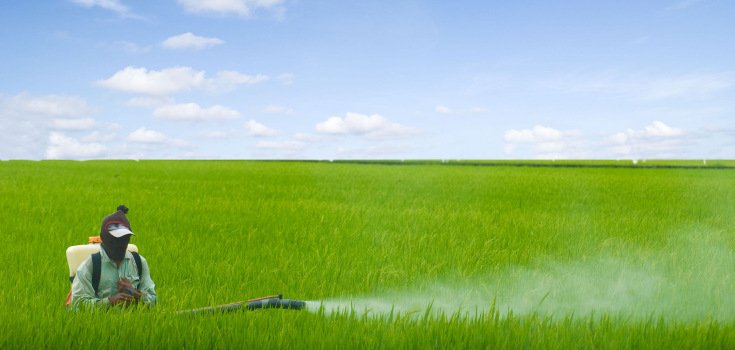New Study: Monsanto’s Herbicides are Breeding Super Bugs

Recently, the World Health Organization (WHO) announced that it had classified glyphosate, the United States’ most widely used herbicide chemical, as “probably carcinogenic to humans.” As if we need another reason to ban Roundup (which contains glyphosate), there is now evidence that the chemicals in Monsanto’s best-selling herbicide also cause antibiotic resistance in harmful bacteria like Escherichia coli and Salmonella enterica serovar Typhimurium.
The study abstract states:
“Increasingly common chemicals…can induce a multiple-antibiotic resistance phenotype in potential pathogens. The effect occurs upon simultaneous exposure to antibiotics and is faster than the lethal effect of antibiotics. The magnitude of the induced response may undermine antibiotic therapy and substantially increase the probability of spontaneous mutation to higher levels of resistance.
The combination of high use of both herbicides and antibiotics in proximity to farm animals and important insects, such as honeybees, might also compromise their therapeutic effects and drive greater use of antibiotics. To address the crisis of antibiotic resistance requires broadening our view of environmental contributors to the evolution of resistance.”
Along with commercial formulations of the herbicides Dicamba, 2,4-dichlorophenoxyacetic acid, glyphosate was shown by researchers to induce an adaptive multiple-antibiotic resistance phenotype.
The abstract also says:
“Killing curves in the presence and absence of sublethal herbicide concentrations showed that the directions and the magnitudes of responses varied by herbicide, antibiotic, and species. When induced, MICs of antibiotics of five different classes changed up to 6-fold.”
The authors say that while many herbicides are tested for toxicity, most are ignored at “sublethal’ levels. This may be ‘lethal’ to human health. Why?
The multitude of chemicals being used in our agricultural fields, gardens, parks, golf courses, and public green spaces can produce a multiple-antibiotic resistance. Giovannoni states:
“The effect occurs upon simultaneous exposure to antibiotics and is faster than the lethal effect of antibiotics. The magnitude of the induced response may undermine antibiotic therapy and substantially increase the probability of spontaneous mutation to higher levels of resistance. The combination of high use of both herbicides and antibiotics in proximity to farm animals and important insects, such as honeybees, might also compromise their therapeutic effects and drive greater use of antibiotics. To address the crisis of antibiotic resistance requires broadening our view of environmental contributors to the evolution of resistance.”
Professor of genetics at the University of Canterbury in New Zealand, Jack Heineman, explains that the herbicides are not killing dangerous bacteria like E.coli and Salmonella because they are not killed outright at the levels typically used to kill unwanted plants in a field.
While some weeds may be killed off (but not always, since farmers have reported the presence of super weeds after using these same chemicals), the bacteria stay alive while activating proteins known as efflux pumps in order to rid themselves of toxins. And this defense mechanism can make the bacteria develop resistance to the threat from which it is defending itself.
Why are these chemicals still being allowed by multiple governments? The reasons they are not currently banned are certainly not based on scientific evidence.
Additional Sources:

One more nail in Consanto’s coffin.
Just released:
Monsanto taking seriously Elon Musk’s claims that robots could turn people into PETS
GM in Canada – lessons learnt
Thirteen years ago when GM soya and rapeseed was introduced in Canada (and in the US) the Corporations and Government told farmers that GM would increase yields, be more nutritious, use less chemicals, and feed a hungry world. Now we will always have a sustainable agriculture, they
claimed. The Canadian Department of Agriculture figures states canola yields have decreased at least ten percent and soya at least fifteen percent [4], but worst of all, farmers are using three to five times more chemicals because of the GM superweeds that have developed. The reality is that the nutritional content of all crops are down fifty percent of what they were before GMOs were introduced and now we have less yields and more chemicals used, exactly the opposite of what Monsanto promised.
Percy Schmeiser said, “Once you introduce GMOs, believe me the days of organic farmers are over, the days of the conventional farmer are over, it all becomes GMOs in a matter of a few years.” In addition, he said, there is no such thing as containment, you cannot contain pollen flow. It doesn’t matter if contamination is by seeds blowing in the wind, or by bees, or by farmers transporting their seeds to market, or so on. Ultimately, farmers, growers and consumers will no longer have a
choice because despite Monsanto’s promise that farmers will have choice, they won’t because it’s absolutely impossible for organic and conventional farming to co-exist with GM crops.